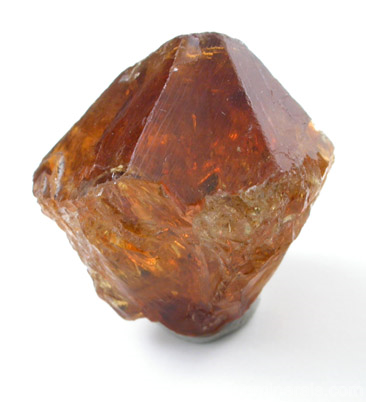The Mineral citrine

Citrine is the yellow to brownish-red variety of the mineral Quartz. It is a widely used as a gemstone, and after Amethyst it is the most popular Quartz gem. Most Citrine is formed by heat treating purple Amethyst. Citrine may also be produced by heat-treating Smoky Quartz from certain
localities. In some Amethyst deposits, the Amethyst has been partially or fully
changed over to yellow Citrine by natural means of heating.
Natural Citrine, which is rare, is yellow to orange-yellow, and occurs in much lighter hues than the heat-treated material, which is dark orange-brown to reddish-brown. Virtually all heat-treated material has a reddish tint, whereas the natural specimens
do not. Natural light yellow Citrine is often called "Lemon Quartz" on the gemstone market. Sometimes Citrine has a "smoky" hue to it, and can be borderlined between Citrine and Smoky Quartz, with either definition being correct.
For additional information, see the gemstone section on Citrine.
Color
Yellow, yellow-brown, orange, dark orange-brown, reddish-brown
Properties
Streak
White |
Hardness
7 |
Transparency
Transparent to translucent |
Specific Gravity
2.6 - 2.7 |
Luster
Vitreous |
Cleavage
Indiscernible |
Fracture
Conchoidal |
Tenacity
Brittle |
Crystal Habits
Most often as protruding clusters of pyramids on a geode base. Also occurs as short, stubby, terminated crystals, either singular or in drusy aggregates, and occasionally as long prismatic crystals and groupings. Also occurs massive and crusty.
Varieties
-
Mixture of Amethyst and Citrine. It is partially purple and partially yellow or orange, with the color zones often sharply divided. More information can be found on the Ametrine gemstone page.
-
Form of Quartz, usually Amethyst, Citrine, or a combination of the two, that contains a large crystal or crystals overgrown with a layer of spiky smaller crystals. Cactus Quartz is specific to Boekenhouthoek (Magaliesberg) in South Africa.
-
Form of naturally colored light yellow Citrine. It is distinguished from most Citrine by lacking orange, brown, or reddish tints.
Uses
Citrine is known mainly for its use as a gemstone. Gems are faceted for jewelry, and it is often used as an inexpensive substitute for Topaz. Citrine is also popular among mineral collectors, and small pieces and drusy plates are often sold to amateur collectors in gift shops.
Noteworthy Localities
Natural Citrine is not common and occurs sparingly in many large Quartz deposits. Most commercial gem-grade material comes from Rio Grande do Sul and Minas Gerais, Brazil, but almost all of the Brazilian material is heat treated Amethyst.
A classic exhausted locality for natural Citrine is Olkhovka in the Northern Ural Mountains, Russia. Other locations where natural Citrine is found is San Cristobal, Santander, Colombia; Lubumbashi in Katanga (Shaba), Congo (Zaire); Antananarivo Province, Madagascar; Salamanca, Spain; and Dauphine, France. In Boekenhoutshoek (Magaliesberg), Mkobola district, South Africa, a unique form of natural Citrine is found together with Amethyst that has a spiky overgrowth of small crystals popularly called "Cactus Quartz".
Common Mineral Associations
White Quartz, Amethyst
Distingushing Similar Minerals
Topaz - Harder (8), has perfect cleavage, different crystal formation.
Chrysoberyl - Harder (8½), different crystal formation.
Apatite - Softer (5), crystal terminations usually differ from Citrine.
Fluorite - Much softer (4), different crystal formation.
Heliodor (Beryl) - Harder (7½ - 8), crystals are usually different (more elongated and perfect hexagons).